The NVIDIA GeForce GTX 780 Ti Review
by Ryan Smith on November 7, 2013 9:01 AM ESTCompute
Jumping into compute, we’re entering the one area where GTX 780 Ti’s rule won’t be nearly as absolute. Among NVIDIA cards its single precision performance will be unchallenged, but the artificial double precision performance limitation as compared to the compute-focused GTX Titan means that GTX 780 Ti will still lose to GTX Titan whenever double precision comes into play. Alternatively, GTX 780 Ti still has to deal with the fact that AMD’s cards have shown themselves to be far more competitive in our selection of compute benchmarks.
As always we'll start with our DirectCompute game example, Civilization V, which uses DirectCompute to decompress textures on the fly. Civ V includes a sub-benchmark that exclusively tests the speed of their texture decompression algorithm by repeatedly decompressing the textures required for one of the game’s leader scenes. While DirectCompute is used in many games, this is one of the only games with a benchmark that can isolate the use of DirectCompute and its resulting performance.
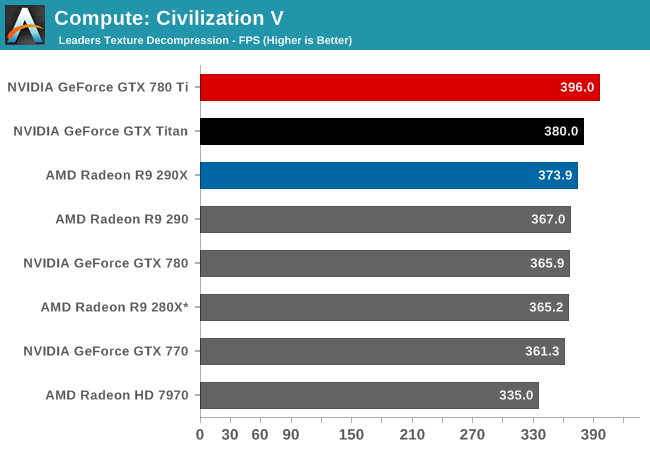
Even though we’re largely CPU bound by this point, GTX 780 Ti manages to get a bit more out of Civilization V’s texture decode routine, pushing it to the top of the charts and ahead of both GTX Titan and 290X.
Our next benchmark is LuxMark2.0, the official benchmark of SmallLuxGPU 2.0. SmallLuxGPU is an OpenCL accelerated ray tracer that is part of the larger LuxRender suite. Ray tracing has become a stronghold for GPUs in recent years as ray tracing maps well to GPU pipelines, allowing artists to render scenes much more quickly than with CPUs alone.
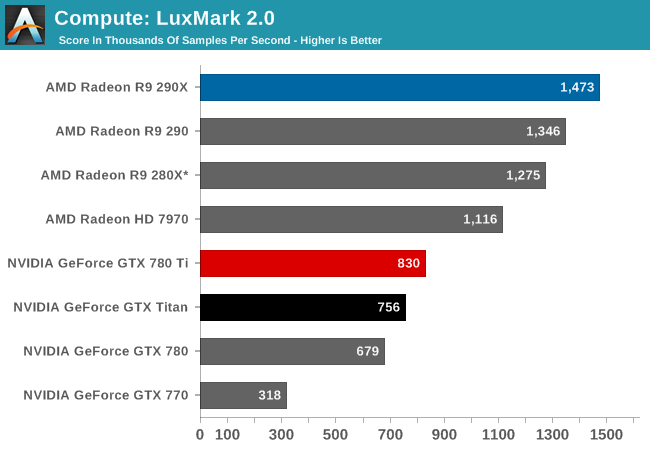
With LuxMark NVIDIA’s ray tracing performance sees further improvements due to the additional compute resources at hand. But NVIDIA still doesn’t fare well here, with the GTX 780 Ti falling behind all of our AMD cards in this test.
Our 3rd compute benchmark is Sony Vegas Pro 12, an OpenGL and OpenCL video editing and authoring package. Vegas can use GPUs in a few different ways, the primary uses being to accelerate the video effects and compositing process itself, and in the video encoding step. With video encoding being increasingly offloaded to dedicated DSPs these days we’re focusing on the editing and compositing process, rendering to a low CPU overhead format (XDCAM EX). This specific test comes from Sony, and measures how long it takes to render a video.

Like LuxMark, GTX 780 Ti once again improves on its predecessors. But it’s not enough to make up for AMD’s innate performance advantage in this benchmark, leading to GTX 780 Ti trailing all of the AMD cards.
Our 4th benchmark set comes from CLBenchmark 1.1. CLBenchmark contains a number of subtests; we’re focusing on the most practical of them, the computer vision test and the fluid simulation test. The former being a useful proxy for computer imaging tasks where systems are required to parse images and identify features (e.g. humans), while fluid simulations are common in professional graphics work and games alike.
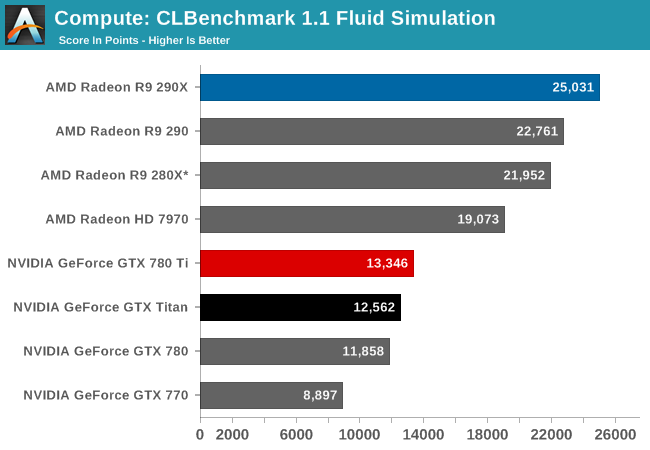
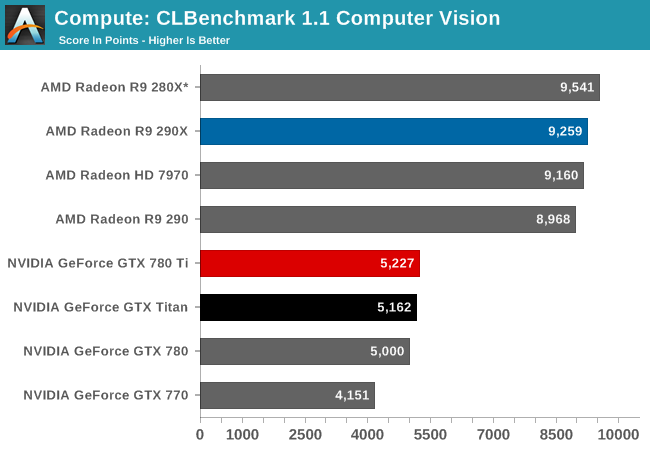
CLBenchmark continues to be the same story. GTX 780 Ti improves on NVIDIA’s performance to become their fastest single precision card, but it still falls short of every AMD card in these tests.
Moving on, our 5th compute benchmark is FAHBench, the official Folding @ Home benchmark. Folding @ Home is the popular Stanford-backed research and distributed computing initiative that has work distributed to millions of volunteer computers over the internet, each of which is responsible for a tiny slice of a protein folding simulation. FAHBench can test both single precision and double precision floating point performance, with single precision being the most useful metric for most consumer cards due to their low double precision performance. Each precision has two modes, explicit and implicit, the difference being whether water atoms are included in the simulation, which adds quite a bit of work and overhead. This is another OpenCL test, as Folding @ Home has moved exclusively to OpenCL this year with FAHCore 17.

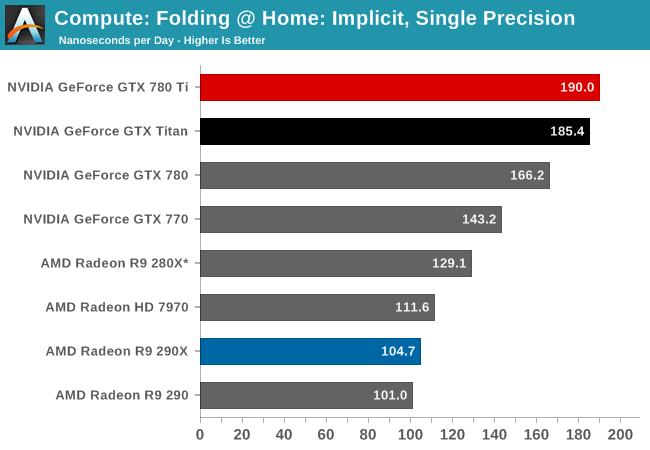
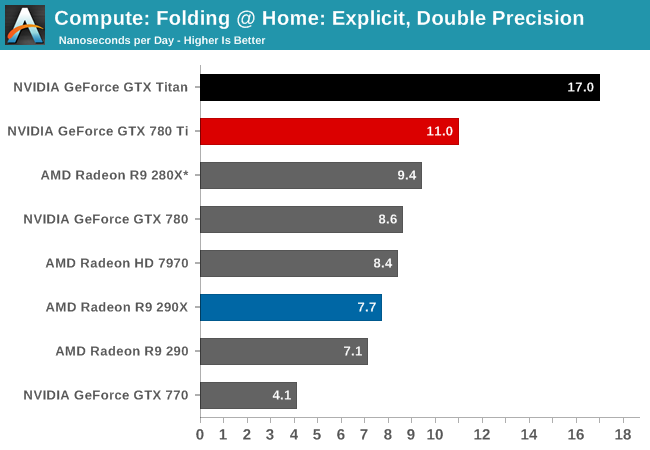
Finally with Folding@Home we see the GTX 780 Ti once again take the top spot. In the single precision tests the GTX 780 further extends NVIDIA’s lead, beating GTX Titan by anywhere between a few percent to over ten percent depending on which specific test we’re looking at. However even with GTX 780 Ti’s general performance increase, in the double precision test it won’t overcome the innate double precision performance deficit it faces versus GTX Titan. When it comes to double precision compute, Titan remains king.
Wrapping things up, our final compute benchmark is an in-house project developed by our very own Dr. Ian Cutress. SystemCompute is our first C++ AMP benchmark, utilizing Microsoft’s simple C++ extensions to allow the easy use of GPU computing in C++ programs. SystemCompute in turn is a collection of benchmarks for several different fundamental compute algorithms, as described in this previous article, with the final score represented in points. DirectCompute is the compute backend for C++ AMP on Windows, so this forms our other DirectCompute test.
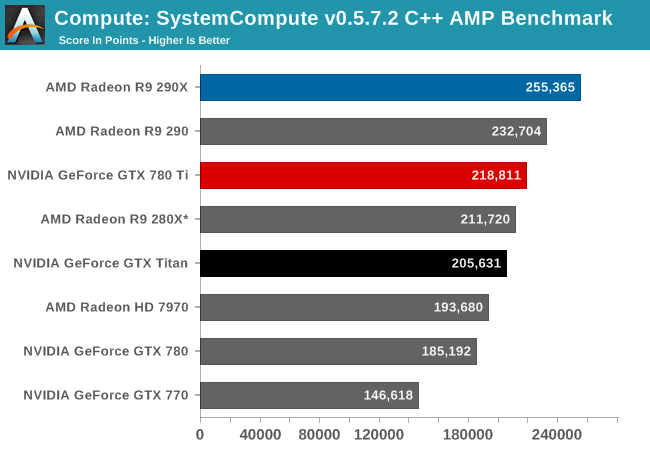
Last, in our C++ AMP benchmark we see the GTX 780 Ti take the top spot for an NVIDIA card, but like so many of our earlier compute tests it will come up short versus AMD’s best cards. This isn’t quite as lopsided as some of our other tests, however GTX 780 Ti is stuck competing with the 280X while the 290 and 290X easily outperform NVIDIA’s new flagship.










302 Comments
View All Comments
fewafwwaefwa - Thursday, November 7, 2013 - link
sterven.looncraz - Thursday, November 7, 2013 - link
When game producers author the games they will do it with a mind towards Mantle and exploiting the AMD GPU characteristics exposed by Mantle on PCs for their console games.When creating portable software you create as thin of an abstraction layer as possible, that layer will now be much closer to the metal with unoptimized DirectX alternatives being manually added. That could very well mean that AMD hardware will have a noticeable advantage on PCs and game producers will only need to do a little extra work to become compatible with other DX-10/11 compatible video cards on Windows/Linux - so nVidia will become something of a "don't forget about me!" rather than "let's build to a generic platform and pull in the nVidia GPU extensions..."
Basstrip - Friday, November 8, 2013 - link
I think they've ALWAYS programmed directly to the core. I think it's safe to assume that the processes translate fairly well and that although they might not be the same, they are similar.It just seems so economic to streamline the whole process. Less of a headache than to constantly try optimize things for multiple platforms.
AMD chips on consoles may not be able to support mantle on the hardware side but programming for consoles and for pc will definitely NOT be 2 completely different things.
elajt_1 - Friday, November 8, 2013 - link
Something I read on Extremetech: Feedback we’ve gotten from other sources continues to suggest that Microsoft’s low-level API for the Xbox One is extremely similar to Mantle, and the difference between the two is basically semantic. This doesn’t square very well with Microsoft’s own statements; we’ll continue to investigate.http://www.extremetech.com/gaming/168671-xbox-one-...
klmccaughey - Monday, November 11, 2013 - link
The difference is a couple of header files. Izzy Wizzy! And you have your API calling code in Xbox transferable to a PC, the header files compile the API's to Mantle API - but both API's are essentailly the same. It couldn't be easier.polaco - Friday, November 8, 2013 - link
The point of mantle I think is to provide an easy way to port from PC to console or Console to PC. So giving the possibility to allow an easier cross compilation.L33T BEANS - Friday, November 8, 2013 - link
Basing someones intelligence on a single statement is unwise.Totally - Sunday, November 10, 2013 - link
Reading these comments makes me wonder, if these people slinging mantle around like a buzzword actually know what it does, because going by the comments alone trying to pitting it against g-sync they clearly don't. Mantle is as relevant to gamers as Cuda is. Yes it does have a direct impact but the benefits aren't for the end user.klmccaughey - Monday, November 11, 2013 - link
You do not understand. The API on the consoles is basically "Mantle". Mantle copies verbatim the API calls for the consoles. They just call it the API on the console. Port the code across, change a few headers, and you have your Mantle calls ;)MonkeyM - Sunday, November 10, 2013 - link
They will sell DIY kits, you don't need a new monitor, as per the press conference.